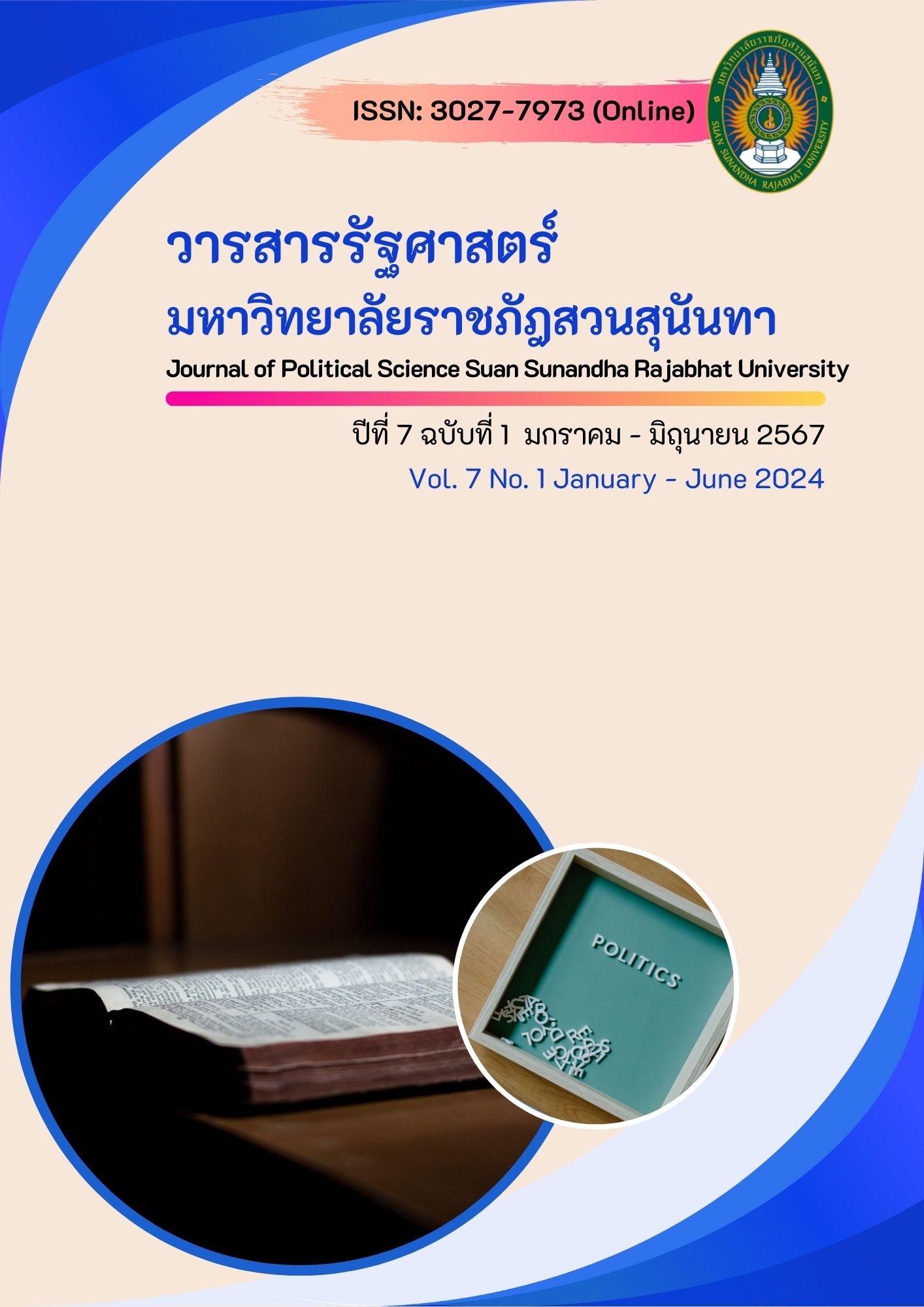ศักยภาพของเกษตรกร กลยุทธ์การตลาดดิจิทัล และนวัตกรรมการจัดการที่มีต่อความสำเร็จของเกษตรกรผู้ปลูกทุเรียนส่งออกในประเทศไทย
Main Article Content
บทคัดย่อ
การวิจัยครั้งนี้ มีวัตถุประสงค์เพื่อศึกษา 1) ระดับตัวแปรศักยภาพของเกษตรกรผู้ปลูกทุเรียน การมุ่งเน้นตลาดความสามารถในการแข่งขัน และความสำเร็จของเกษตรกรผู้ปลูกทุเรียนส่งออกทุเรียนในประเทศไทย 2) อิทธิพลของตัวแปรศักยภาพของเกษตรกรผู้ปลูกทุเรียน การมุ่งเน้นตลาดความสามารถในการแข่งขัน ที่มีผลต่อความสำเร็จของเกษตรกรผู้ปลูกทุเรียนส่งออกทุเรียนในประเทศไทย 3) สร้างแบบจำลองความสำเร็จของเกษตรกรผู้ปลูกทุเรียนส่งออกทุเรียนในประเทศไทย ใช้การวิจัยแบบผสานผสาน การวิจัยเชิงปริมาณ กลุ่มตัวอย่าง คือ เกษตรกรผู้ปลูกทุเรียนส่งออกทุเรียนในประเทศไทย จำนวน 320 ตัวอย่าง ขนาดของกลุ่มตัวอย่างกำหนดโดยใช้เกณฑ์ 20 เท่าของตัวแปรสังเกต ใช้วิธีการสุ่มกลุ่มตัวอย่างแบบหลายขั้นตอน ใช้แบบสอบถามในการเก็บข้อมูล วิเคราะห์ข้อมูลด้วยแบบจำลองสมการโครงสร้าง ส่วนการวิจัยเชิงคุณภาพใช้วิธีการสัมภาษณ์แบบแบบเจาะลึก กลุ่มผู้ให้ข้อมูลหลัก คือผู้ประกอบการส่งออกทุเรียนในประเทศไทย และผู้เชี่ยวชาญด้านการส่งออกทุเรียนใน
ผลการวิจัยพบว่า 1) ศักยภาพของเกษตรกรผู้ปลูกทุเรียน การมุ่งเน้นตลาด ความสามารถในการแข่งขัน และความสำเร็จของเกษตรกรผู้ปลูกทุเรียนส่งออกทุเรียนในประเทศไทย อยู่ในระดับมาก 2) ศักยภาพของเกษตรกรผู้ปลูกทุเรียน การมุ่งเน้นตลาดความสามารถในการแข่งขันที่มีต่อความสำเร็จของเกษตรกรผู้ปลูกทุเรียนส่งออกทุเรียนในประเทศไทย และ 3) แบบจำลองความสำเร็จของเกษตรกรผู้ปลูกทุเรียนส่งออกทุเรียนในประเทศไทย ที่ผู้วิจัยพัฒนาขึ้น มีชื่อว่า PMCS Model (P = Potential, M = Market Oriented, C = Competitiveness, S = Success of durian farmers exporting) นอกจากนี้ ผลการวิจัยเชิงคุณภาพ
ยังพบว่า ในการสร้างความสำเร็จของเกษตรกร ผู้ปลูกทุเรียนส่งออกทุเรียนนั้น ผู้ประกอบการต้องให้ความสำคัญในการขายและการขนส่งโลจิสติกส์ภายใต้แพลตฟอร์มอีคอมเมิร์ซ และการใช้เทคโนลียีที่ทันสมัยมาช่วยเพิ่มประสิทธิภาพในการประชาสัมพันธ์เพื่อสร้างการรับรู้ให้กับเกษตรกรในการควบคุมขั้นตอนการปลูกและรักษาคุณภาพทุเรียนให้ตรงตามมาตรฐานเพื่อการส่งออก ผลของงานวิจัยนี้สามารถนำไปปรับใช้เป็นแนวทางกำหนดนโยบายในการดำเนินธุรกิจ เพื่อส่งเสริมความสำเร็จของเกษตรกรผู้ปลูกทุเรียนส่งออกทุเรียนในประเทศอย่างยั่งยืนต่อไป
Article Details
เอกสารอ้างอิง
กรมศุลกากร. (2565). ปริมาณการส่งออกทุเรียนไปต่างประเทศ. ค้นเมื่อ 20 เมษายน 2567, http://www.customs.go.th/statistic_report.php?show_search=1&s=oLuGdLhgyscAYMay
จันทิมา พรหมเกษ, จักเรศ เมตตาธรรม และ วรรณิดา สารีคำ. (2562). ผลกระทบของศักยภาพผู้ประกอบการสมัยใหม่และนวัตกรรมการตลาดที่มีต่อความได้เปรียบทางการแข่งขันของวิสาหกิจชุมชนกลุ่มแปรรูปผลิตผลทางการเกษตรในเขตภาคตะวันออกเฉียงเหนือตอนบน. วารสารสังคมศาสตร์ สุรนารี, 13(2), 80.
Awan, A. G. and Hashmi, S. (2014). Marketing Practices of Small and Medium Size Enterprises: A Case Study of SMEs in Multan District. European Journal of Business and Innovation Research, 2(6), 9-20.
Ahmed, F. U. and Brennan, L. (2019). An institution-based view of firms’ early internationalization: Effectiveness of national export promotion policies. InternationalMarketing Review, 36(6), 911-954.
Aiolfi, S., Bellini, S. and Pellegrini, D. (2021). Data-driven digital advertising: benefits and risks of online behavioral advertising. International Journal of Retail and Distribution Management, 49(7), 1089-1110.
Cavazza, A., Dal Mas, F., Paoloni, P. and Manzo, M. (2023). Agricultural and Food Sciences, Business. British Food Journal, 125(1), 123-135.
Capelleras, J., Domi, S. and Belletti, G. (2021). Skill-enhancing human resource practices and firm performance: the mediating role of innovativeness. Tourism Review, 76(6), 1279 –1296.
Creswell, J. W. (2003). Research Design: Qualitative, quantitative, and mixed methods approaches. 2nd ed. Thousand Oaks, CA: Sage.
Gautam, P., Maheshwari, S., Kaushal-Deep, S. M., Bhat, A. R. and Jaggi, C. K. (2020). COVID-19: A bibliometric analysis and insights. International Journal of Mathematical, Engineering and Management Sciences, 5(6), 1156-1169.
Karing'u, K. N., Isaboke, H. N. and Ndirangu, S. N. (2020), Transaction costs and participation in avocado export marketing in Murang’a County, Kenya. Journal of Agribusiness in Developing and Emerging Economies, 11(3), 221-240.
Luo, P., Ngai, EWT and Cheng, TCE. (2024). Supply chain network structures and firm financial performance: the moderating role of international relations. International Journal of Operations and Production Management, 44(1), 75-98.
Likert, R. (1932). A Technique for the Measurement of Attitudes. Archives of Psychology, 140, 1–55.
Sureeyatanapas, P., Pancharoen, D. and Saengprachatanarug, K. (2023). Finding the sweet spot in Industry 4.0 transformation: an exploration of the drivers, challenges and readiness of the Thai sugar industry. Benchmarking: An International Journal, Vol. ahead-of-print No. ahead-of-print. https://www.emerald.com/insight/content/doi/10.1108/BIJ-10-2022-0625/full/html
Sharma, H. and Aggarwal, A.G. (2019). Finding determinants of e-commerce success: a PLS-SEM approach. Journal of Advances in Management Research, 16(4), 453–471.
Sumi, R.S. and Ahmed, M. (2022). Investigating young consumers’ online buying behavior in COVID-19 pandemic: perspective of Bangladesh. IIM Ranchi Journal of Management Studies, 1(2), 108-123.
Wang, C. et al. (2020) A Novel Coronavirus Outbreak of Global Health Concern. The Lancet, 395, 470-473.
Wheelen, T.L. and Hunger, J.D. (2012). Strategic management and business policy: toward global sustainability. (13th ed). Boston: Pearson.
William, A. J., Suresh, M. and Subramanian, N. (2023). Examining the causal relationships among factors influencing SMEs' competitive advantage: a TISM-neutrosophic MICMAC approach. Benchmarking: An International Journal, Vol. ahead-of-print No. ahead-of-print. https://doi.org/10.1108/BIJ-08-2022-0529
Yin, M. and Li, J. (2023). How market orientation affects open innovation? Exploring the role of information and communication technology capability. European Journal of Innovation Management, 27(6), 1885-1911.
Zhang, F., Zhang, Q. and Wu, H. (2023). Robot adoption and export performance: evidence from Chinese industrial firms. Journal of Manufacturing Technology Management, 34(6), 896-916.


